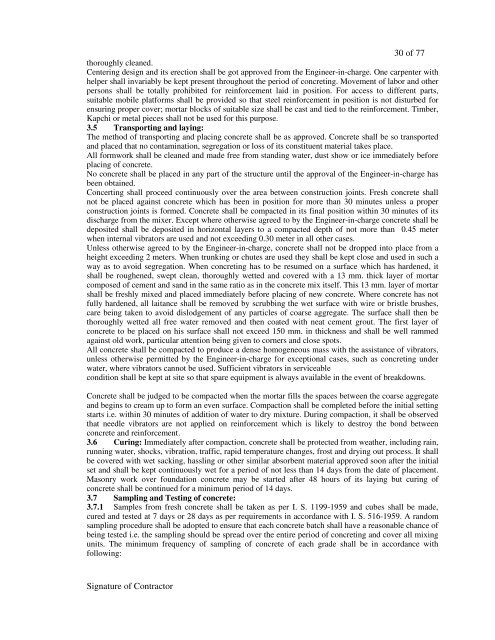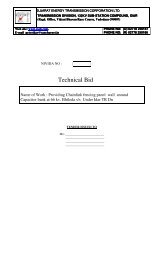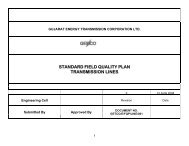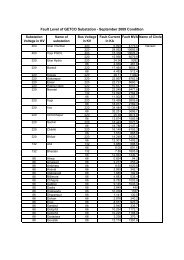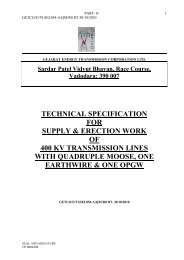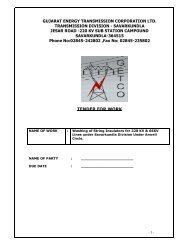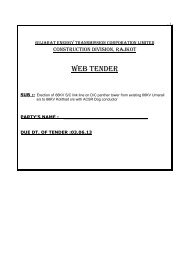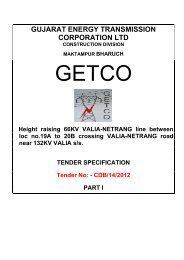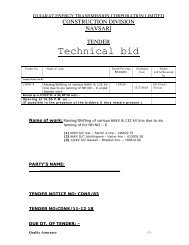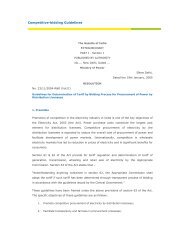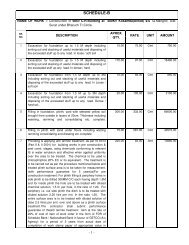SECTION-E: TENDER AND CONTRACT FOR WORKS
SECTION-E: TENDER AND CONTRACT FOR WORKS
SECTION-E: TENDER AND CONTRACT FOR WORKS
Create successful ePaper yourself
Turn your PDF publications into a flip-book with our unique Google optimized e-Paper software.
30 of 77<br />
thoroughly cleaned.<br />
Centering design and its erection shall be got approved from the Engineer-in-charge. One carpenter with<br />
helper shall invariably be kept present throughout the period of concreting. Movement of labor and other<br />
persons shall be totally prohibited for reinforcement laid in position. For access to different parts,<br />
suitable mobile platforms shall be provided so that steel reinforcement in position is not disturbed for<br />
ensuring proper cover; mortar blocks of suitable size shall be cast and tied to the reinforcement. Timber,<br />
Kapchi or metal pieces shall not be used for this purpose.<br />
3.5 Transporting and laying:<br />
The method of transporting and placing concrete shall be as approved. Concrete shall be so transported<br />
and placed that no contamination, segregation or loss of its constituent material takes place.<br />
All formwork shall be cleaned and made free from standing water, dust show or ice immediately before<br />
placing of concrete.<br />
No concrete shall be placed in any part of the structure until the approval of the Engineer-in-charge has<br />
been obtained.<br />
Concerting shall proceed continuously over the area between construction joints. Fresh concrete shall<br />
not be placed against concrete which has been in position for more than 30 minutes unless a proper<br />
construction joints is formed. Concrete shall be compacted in its final position within 30 minutes of its<br />
discharge from the mixer. Except where otherwise agreed to by the Engineer-in-charge concrete shall be<br />
deposited shall be deposited in horizontal layers to a compacted depth of not more than 0.45 meter<br />
when internal vibrators are used and not exceeding 0.30 meter in all other cases.<br />
Unless otherwise agreed to by the Engineer-in-charge, concrete shall not be dropped into place from a<br />
height exceeding 2 meters. When trunking or chutes are used they shall be kept close and used in such a<br />
way as to avoid segregation. When concreting has to be resumed on a surface which has hardened, it<br />
shall be roughened, swept clean, thoroughly wetted and covered with a 13 mm. thick layer of mortar<br />
composed of cement and sand in the same ratio as in the concrete mix itself. This 13 mm. layer of mortar<br />
shall be freshly mixed and placed immediately before placing of new concrete. Where concrete has not<br />
fully hardened, all laitance shall be removed by scrubbing the wet surface with wire or bristle brushes,<br />
care being taken to avoid dislodgement of any particles of coarse aggregate. The surface shall then be<br />
thoroughly wetted all free water removed and then coated with neat cement grout. The first layer of<br />
concrete to be placed on his surface shall not exceed 150 mm. in thickness and shall be well rammed<br />
against old work, particular attention being given to corners and close spots.<br />
All concrete shall be compacted to produce a dense homogeneous mass with the assistance of vibrators,<br />
unless otherwise permitted by the Engineer-in-charge for exceptional cases, such as concreting under<br />
water, where vibrators cannot be used. Sufficient vibrators in serviceable<br />
condition shall be kept at site so that spare equipment is always available in the event of breakdowns.<br />
Concrete shall be judged to be compacted when the mortar fills the spaces between the coarse aggregate<br />
and begins to cream up to form an even surface. Compaction shall be completed before the initial setting<br />
starts i.e. within 30 minutes of addition of water to dry mixture. During compaction, it shall be observed<br />
that needle vibrators are not applied on reinforcement which is likely to destroy the bond between<br />
concrete and reinforcement.<br />
3.6 Curing: Immediately after compaction, concrete shall be protected from weather, including rain,<br />
running water, shocks, vibration, traffic, rapid temperature changes, frost and drying out process. It shall<br />
be covered with wet sacking, hassling or other similar absorbent material approved soon after the initial<br />
set and shall be kept continuously wet for a period of not less than 14 days from the date of placement.<br />
Masonry work over foundation concrete may be started after 48 hours of its laying but curing of<br />
concrete shall be continued for a minimum period of 14 days.<br />
3.7 Sampling and Testing of concrete:<br />
3.7.1 Samples from fresh concrete shall be taken as per I. S. 1199-1959 and cubes shall be made,<br />
cured and tested at 7 days or 28 days as per requirements in accordance with I. S. 516-1959. A random<br />
sampling procedure shall be adopted to ensure that each concrete batch shall have a reasonable chance of<br />
being tested i.e. the sampling should be spread over the entire period of concreting and cover all mixing<br />
units. The minimum frequency of sampling of concrete of each grade shall be in accordance with<br />
following:<br />
Signature of Contractor


